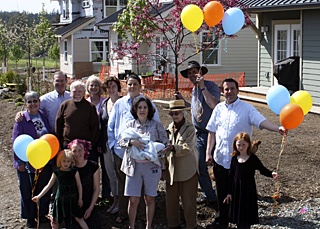It began with a small group of volunteers who had a simple vision: an alternative form of land ownership that would perpetuate an ethic of stewardship.
Since its incorporation in 1989, “Of People and Land” Community Land Trust has grown into a thriving island resource, responsible for creating 77 permanently affordable homes, seven rental apartments and 3,600 square feet of office space.
By bringing together community support, state and federal grants, low-interest loans, and thousands of volunteer hours, OPAL creates permanently affordable homes for creditworthy Orcas families and individuals who are excluded from the private market because of their income levels.
In most cases, applicants for OPAL homes can earn no more than 80 percent of the median income for San Juan County (in 2009: $37,400 for one person, $42,750 for two, and $48,100 for a family of three). However, a limited number of homes are available to people earning more than 80 percent of median income who cannot afford to buy a market-rate home on Orcas. There are also asset limits and residency and community service requirements.
“I’ve seen OPAL evolve into something that is closer to what the founders originated,” Executive Director Lisa Byers said. “The founders didn’t expect such strict limitations on who would be eligible to own. The funding options that would bring the vision into reality limited those we could serve. Over the years we’ve been able to serve a more diverse group of folks.”
The organization was started by Peter Fisher and Michael and Penny Sharp Sky, who will be honored on Friday, May 29 during the OPAL birthday celebration and annual meeting from 4 to 7 p.m. in the Wild Rose Meadow neighborhood on Rosehip Road (at the intersection with Mt. Baker Road).
Grilled hot dogs, veggie kabobs and condiments will be provided; bring a salad or dessert to share, plus your own plate, utensils and beverage. Musical entertainment will be provided by OPAL homeowners and guests. There will also be tours of two recently completed homes, children’s activities, and a brief annual meeting. Guests are asked to park at Orcas Center or the Medical Center; limited on-site parking is available for anyone who has difficulty walking.
OPAL’s five neighborhoods, six scattered site homes, and apartments are home to 84 families, which encompasses nearly three percent of the island’s households. When resales are included, OPAL has served 100 different Orcas families over 20 years. When the final 14 homes in Wild Rose Meadow are completed next year, OPAL will have provided 91 houses.
OPAL homeowners hold down jobs in healthcare, education, construction, retail, food service, banks and offices, maintenance, and the arts. Of the island’s school-age children, 10 percent currently live in OPAL homes and neighborhoods. Five of the 27 seniors graduating this year from Orcas High School are OPAL residents, including both the valedictorian and salutatorian.
“I think it’s enabled people to live on the island,” Orcas School Superintendent Barbara Kline said. “We have families and teachers who would not be comfortable living on the island without the OPAL homes. It’s had an incredibly positive impact on families and teachers for providing stable homes.”
The OPAL neighborhoods are: Opal Commons, 18 homes, completed in 1994; Bonnie Brae, 24 homes, completed in 1999; Oberon Wood, five homes, completed in 2002; Lahari Ridge, six homes, completed in 2005; Wild Rose Meadow, 32 homes, first 18 homes will be completed by July 2009, and final 14 homes are scheduled to be finished in 2010.
The land is owned by the community land trust and leased to each homeowner, who must qualify for a mortgage to buy the house. After acquiring the land, OPAL designs and builds homes to meet the needs of prequalified applicants and its green building guidelines.
OPAL has six houses scattered around the island: one in Olga and two in Eastsound that were bought and renovated; two Madrona Street cottages built on a donated lot; and one at Obstruction Pass that was purchased through OPAL’s first legacy gift. It also has seven rental apartments and office space on the Reddick property in Eastsound.
In 2008, OPAL brought almost $1.1 million in grant revenue to Orcas and oversaw the expenditure of more than $3.7 million, the bulk of which paid for construction of the first 18 homes in Wild Rose Meadow. OPAL hires and buys locally; this includes excavation, site work, construction and landscaping, as well as construction materials. OPAL is employing 15 to 20 island residents on the Wild Rose Meadow project.
“We’re building a more green and a more durable home than when we first started,” Byers, who has been with OPAL since 1996, said. “The marketplace has changed. There is a much greater awareness than before, and green products are more affordable. Our success from our early projects helped build trust in the community that we were a good investment, which has enabled us to build a better product.”
Byers is also the founding president of the National Community Land Trust Network, and she, along with some of her staff, teach throughout the U.S.
“We’ve learned a lot through the years,” she said. “We’ve learned from our mistakes. Throughout our work on the island and coaching other places on getting started with land trusts, we’ve picked up a lot of good ideas from around the country. We’ve taken what we’ve learned out into the world and brought back other perspectives.”
Orcas elementary teacher Mathew Chasanof, who lives in Bonnie Brae, says
QUOTE FROM MATTHEW.
SIDEBAR:
OPAL’S FUTURE PLANS:
OPAL acquired land in Orcas Village for up to 12 homes; land also remains for six additional homes in the Oberon Wood neighborhood. The organization may also play a bigger role in the affordable rental market; OPAL has entered into an agreement to purchase the Lavender Hollow apartments, pending new grants for purchase and renovation.



